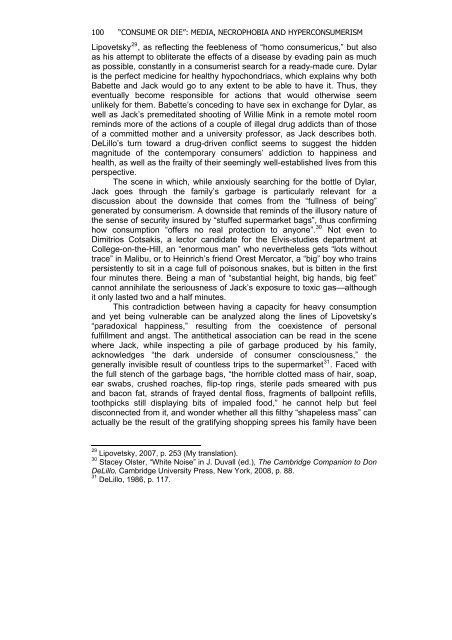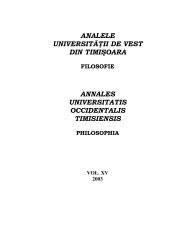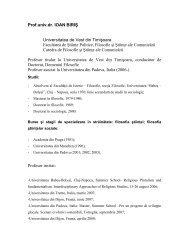VOL. IV (XXI) 2009 - Departamentul de Filosofie si Stiinte ale ...
VOL. IV (XXI) 2009 - Departamentul de Filosofie si Stiinte ale ...
VOL. IV (XXI) 2009 - Departamentul de Filosofie si Stiinte ale ...
Create successful ePaper yourself
Turn your PDF publications into a flip-book with our unique Google optimized e-Paper software.
100 “CONSUME OR DIE”: MEDIA, NECROPHOBIA AND HYPERCONSUMERISM<br />
Lipovetsky 29 , as reflecting the feebleness of “homo consumericus,” but also<br />
as his attempt to obliterate the effects of a disease by evading pain as much<br />
as pos<strong>si</strong>ble, constantly in a consumerist search for a ready-ma<strong>de</strong> cure. Dylar<br />
is the perfect medicine for healthy hypochondriacs, which explains why both<br />
Babette and Jack would go to any extent to be able to have it. Thus, they<br />
eventually become respon<strong>si</strong>ble for actions that would otherwise seem<br />
unlikely for them. Babette’s conceding to have sex in exchange for Dylar, as<br />
well as Jack’s premeditated shooting of Willie Mink in a remote motel room<br />
reminds more of the actions of a couple of illegal drug addicts than of those<br />
of a committed mother and a univer<strong>si</strong>ty professor, as Jack <strong>de</strong>scribes both.<br />
DeLillo’s turn toward a drug-driven conflict seems to suggest the hid<strong>de</strong>n<br />
magnitu<strong>de</strong> of the contemporary consumers’ addiction to happiness and<br />
health, as well as the frailty of their seemingly well-established lives from this<br />
perspective.<br />
The scene in which, while anxiously searching for the bottle of Dylar,<br />
Jack goes through the family’s garbage is particularly relevant for a<br />
discus<strong>si</strong>on about the down<strong>si</strong><strong>de</strong> that comes from the “fullness of being”<br />
generated by consumerism. A down<strong>si</strong><strong>de</strong> that reminds of the illusory nature of<br />
the sense of security insured by “stuffed supermarket bags”, thus confirming<br />
how consumption “offers no real protection to anyone”. 30 Not even to<br />
Dimitrios Cotsakis, a lector candidate for the Elvis-studies <strong>de</strong>partment at<br />
College-on-the-Hill, an “enormous man” who nevertheless gets “lots without<br />
trace” in Malibu, or to Heinrich’s friend Orest Mercator, a “big” boy who trains<br />
per<strong>si</strong>stently to <strong>si</strong>t in a cage full of poisonous snakes, but is bitten in the first<br />
four minutes there. Being a man of “substantial height, big hands, big feet”<br />
cannot annihilate the seriousness of Jack’s exposure to toxic gas—although<br />
it only lasted two and a half minutes.<br />
This contradiction between having a capacity for heavy consumption<br />
and yet being vulnerable can be analyzed along the lines of Lipovetsky’s<br />
“paradoxical happiness,” resulting from the coexistence of personal<br />
fulfillment and angst. The antithetical association can be read in the scene<br />
where Jack, while inspecting a pile of garbage produced by his family,<br />
acknowledges “the dark un<strong>de</strong>r<strong>si</strong><strong>de</strong> of consumer consciousness,” the<br />
generally invi<strong>si</strong>ble result of countless trips to the supermarket 31 . Faced with<br />
the full stench of the garbage bags, “the horrible clotted mass of hair, soap,<br />
ear swabs, crushed roaches, flip-top rings, sterile pads smeared with pus<br />
and bacon fat, strands of frayed <strong>de</strong>ntal floss, fragments of ballpoint refills,<br />
toothpicks still displaying bits of imp<strong>ale</strong>d food,” he cannot help but feel<br />
disconnected from it, and won<strong>de</strong>r whether all this filthy “shapeless mass” can<br />
actually be the result of the gratifying shopping sprees his family have been<br />
29 Lipovetsky, 2007, p. 253 (My translation).<br />
30 Stacey Olster, “White Noise” in J. Duvall (ed.), The Cambridge Companion to Don<br />
DeLillo, Cambridge Univer<strong>si</strong>ty Press, New York, 2008, p. 88.<br />
31 DeLillo, 1986, p. 117.




